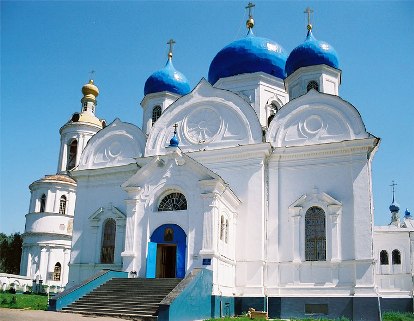

Nestled within the Holy Bogolyubovo Monastery in the village of Bogolyubovo, Vladimir Oblast, Russia, the Cathedral of the Bogolyubskaya Icon of the Mother of God—commonly known as the Cathedral of Our Lady—stands as the most imposing and central edifice in this historic complex. Part of Russia's famed Golden Ring of ancient towns, this Orthodox cathedral honors the miraculous Bogolyubskaya Icon of the Theotokos, a sacred artifact deeply embedded in Russian spiritual lore. Erected in the 19th century, it exemplifies the era's Russian ecclesiastical design, merging opulent aesthetics with profound religious symbolism, and continues to draw pilgrims and visitors as a vibrant site of worship and cultural heritage. The monastery itself, one of Russia's oldest, traces its roots to the 13th century on the grounds of Prince Andrei Bogolyubsky's former palace, blending medieval origins with later architectural developments.
The cathedral's story is deeply intertwined with the establishment of
Bogolyubovo and its monastery by Grand Prince Andrei Bogolyubsky in the
12th century. In 1155, during his journey from Vyshgorod to the Suzdal
Principality, Andrei carried the revered Vladimir Icon of the Mother of
God—a Byzantine masterpiece traditionally attributed to St. Luke.
Approximately 11 versts (about 7 miles) from Vladimir, near the meeting
point of the Nerl and Klyazma Rivers, the horses transporting the icon
inexplicably halted on the riverbank and refused to proceed, despite
efforts to replace them. Interpreting this as a divine omen, Andrei
ordered a moleben (prayer service) and retired to his tent for solitary
prayer. There, the Theotokos appeared to him, instructing him to place
the Vladimir Icon in Vladimir and build a church and monastery at that
very spot. In 1157, to honor this apparition, he commissioned the
Bogolyubskaya Icon, painted on cypress wood by iconographers who
depicted the Mother of God in a full-length, standing pose with arms
raised in prayer, her gaze directed toward a blessing Christ figure in
the upper corner—elements that may have been added or modified over
time, including a scroll in her hand and Deisis figures above. This
icon, now preserved in the Knyaginin Convent in Vladimir, is credited
with numerous miracles, such as saving the city from a plague in 1771.
From this foundation, Andrei founded the settlement of Bogolyubovo
("God-loving") around 1158, complete with a church, palace, and
fortifications. The site included white-stone buildings like the Church
of the Nativity of the Virgin (constructed 1158–1165, rebuilt after a
1722 collapse that trapped the icon under rubble for days) and palace
remnants. The area faced repeated hardships, including a sack by Prince
Gleb of Ryazan in 1177 and the devastating Mongol invasion of 1238 under
Batu Khan, which razed much of Vladimir but spared the icon amid the
flames. A formal monastery emerged in the 13th century, with expansions
accelerating after Andrei's canonization in 1702.
The present-day
cathedral was built during a 19th-century revival, with its foundation
laid on May 19, 1855, and consecration on May 20, 1866. Supported by
donations from figures like Moscow merchant A. G. Alekseev, it reflected
the broader Orthodox architectural renaissance under Emperors Nicholas I
and Alexander II, emphasizing Byzantine roots and Russian national
pride. Despite Soviet-era closures and repurposing of monasteries, the
cathedral endured and was revitalized after 1991 as an active convent
for nuns, with recent restorations including dome repainting and
interior fresco renewals.
Crafted by the eminent architect Konstantin Ton—best known for
Moscow's Cathedral of Christ the Savior (1839–1883)—the Bogolyubovo
cathedral is viewed as a more compact iteration of Ton's iconic work,
incorporating similar design motifs and structural innovations. It
embodies the Russo-Byzantine Revival style, fusing grand Byzantine forms
with Russian neoclassical touches, which was fashionable for evoking the
splendor of Kievan Rus' while integrating contemporary engineering.
External Appearance: The cathedral forms a monumental
cross-in-square plan, crowned by a prominent central dome surrounded by
four smaller ones, symbolizing Christ and the Evangelists. Its
onion-shaped domes, gilded and recently restored to a brilliant shine,
rise dramatically against the landscape. The white-stone facades feature
ornate arches, pilasters, and decorative carvings that emphasize height
and elegance, harmonizing with the monastery's older white-limestone
structures.
Internal Configuration: The interior boasts expansive,
vaulted spaces ideal for mass gatherings and liturgical processions. A
lavish iconostasis, embellished with gold, intricate woodwork, and
sacred images, separates the nave from the altar. Expansive frescoes
cover the walls, illustrating scriptural narratives, hagiographies, and
pivotal moments in Russian history, rivaling the artistry of Ton's
Moscow cathedral. A notable technological feat is the 19th-century
underfloor air-heating system, using ducts and convection to provide
efficient warmth during severe winters—a forward-thinking element that
still functions effectively today.
Scale and Integration: As the
monastery's largest structure, it can host thousands, its dimensions
underscoring Ton's vision of inspirational sacred spaces. It houses
replicas of the Bogolyubskaya Icon, portraying the Theotokos in an
intercessory stance with Prince Andrei often shown kneeling in devotion.
The cathedral complements nearby landmarks, including the 18th-century
rebuilt Nativity Cathedral (with 12th-century fragments) and the
exquisite Church of the Intercession on the Nerl (1165), a UNESCO-listed
gem just a short distance away.
This cathedral holds immense religious value as the guardian of the Bogolyubskaya Icon's tradition, with its feast observed on July 1 (New Style) or June 18 (Old Style), drawing crowds for celebrations. It symbolizes enduring faith from medieval times to the present, themes of heavenly intervention, royal devotion, and national endurance. As a Golden Ring highlight, it lures tourists, scholars, and devotees eager to explore Orthodox legacy. Now a thriving nunnery, the monastery conducts daily services, hosts festivals, and runs educational initiatives while pursuing conservation efforts. Its picturesque setting amid riverside meadows has earned it the moniker "poetry in stone," encapsulating the serene beauty of Bogolyubovo's UNESCO-protected ensemble.